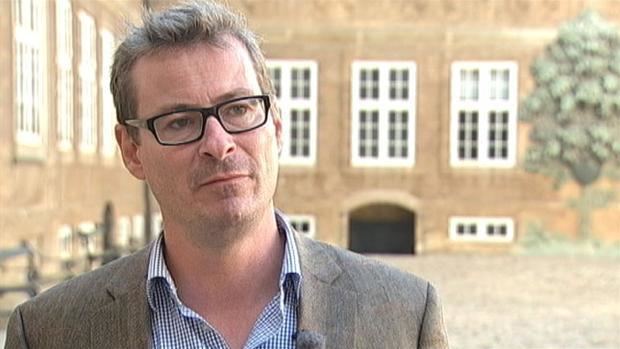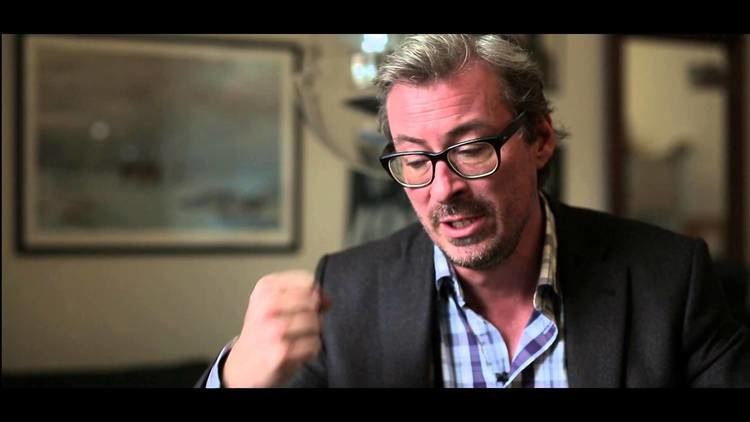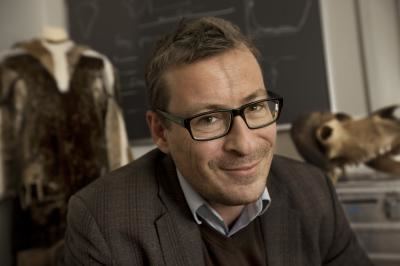Nationality Danish Parents Richard Willerslev | Name Eske Willerslev Fields Evolutionary biology Role Evolutionary Biologist | |
Siblings Rane Willerslev, Anne Willerslev | ||
Education University of Copenhagen | ||
Eske willerslev hunting the molecular past
Eske Willerslev (born 5 June 1971) is a Danish evolutionary geneticist notable for his pioneering work in molecular anthropology, palaeontology, and ecology. He currently holds the Prince Philip Professorship in Ecology and Evolution at University of Cambridge, UK and the Lundbeck Foundation Professorship in Evolution at Copenhagen University, Denmark. He is director of the Centre of Excellence in GeoGenetics, a research associate at the Wellcome Trust Sanger Institute, and a Professorial Fellow at St John's College, Cambridge.
Contents
- Eske willerslev hunting the molecular past
- Why human history teaches us to travel eske willerslev tedxkea
- Early life and education
- Career
- Environmental DNA
- First sequencing of an ancient human genome
- Early peopling of the Americas
- Peopling of Australia
- Early peopling of Europe
- Other research
- Outreach
- Personal life
- References

Why human history teaches us to travel eske willerslev tedxkea
Early life and education
Villerslev was born in Gentofte north of Copenhagen as the son of the historian Richard Willerslev and identical twin brother of the anthropologist Rane Willerslev. He attended Ordrup Gymnasium.

Before becoming a scientist Willerslev led several expeditions in Siberia in the early 1990s with his twin brother, collecting ethnographic materials and megafauna skeleton remains that are stored at Moesgaard Museum in Denmark (the largest Siberian ethnographical collection in Denmark). Willerslev also lived as a fur trapper in the Sakha (Yakutia) Republic from 1993–94. Willerslev handed in his PhD thesis as a doctor thesis and obtained his DSc at Copenhagen University in 2004.
Career

He moved to Oxford University as an independent Wellcome Trust Fellow, and became full professor at Copenhagen University at the age of 33. In 2015 Willerslev took up the Prince Philip Chair in Ecology and Evolution at the Department of Zoology at University of Cambridge. Willerslev is a Foreign Associate Member of The National Academy of Sciences (USA), elected member of the Royal Danish Academy of Sciences and Letters, and Honorary Doctor at University of Oslo. He has been a visiting professor at Oxford University, UK, and a Visiting Miller Professor at UC Berkeley. In 2014, he became an adopted member of the Crow Tribe in Montana (Apsaalooke), where he carries the name ChiitdeeXia’ssee (Well Known Scout).

He has received several awards including the Antiquity Prize for the best paper in the journal Antiquity in 2009, the Danish Independent Research Council's Major EliteForsk Prize, the Rosenkjær Award and the Genius Award (Geniusprisen) of Danish Science journalists for "an impressive array of research successes in the public eye, combined with a unique tour-de-force through university".
Environmental DNA

During his MSc project Willerslev and colleagues were the first to obtain ancient DNA directly from ice cores. Later, Willerslev and his team expanded on this approach and was the first to show that DNA from plants, mammals and birds can be obtained directly from environmental samples (environmental DNA) ancient as well as modern. He later showed that environmental DNA can also be obtained from a variety of settings including basal ice and revealed a forested Greenland some 400,000 years ago questioning if southern Greenland was ice free during the last interglacial. His team has also used environmental DNA to reveal forested refugia in Scandinavia during the last interglacial, and that forbs rather than grasses were dominating the steppe environments of the northern hemisphere during the Pleistocene and was an important food source for the megafauna.
Using environmental DNA, Willerslev and collaborators estimated that woolly mammoth in mainland Alaska survived more than 3,500 years earlier than previously thought, thereby dismissing the Blitzkrieg and Impact hypotheses for megafauna extinction. They also clarified the importance of climate change as a driver of megafauna population dynamics, and the decline of protein rich forbs during the Pleistocene extinctions.
First sequencing of an ancient human genome
In 2010, a team led by Willerslev sequenced the genome of a 4,000-year-old man from the Saqqaq culture of Greenland from his hair. This was the first ancient human genome to be sequenced. The DNA obtained from the hair was fragmented into an average size of 55 base pairs. They revealed that the Saqqaq peoples represent a migration from Siberia to the Americas that is separate from that of Native American and Inuit ancestors. In 2014 his team showed that all paleoeskimos in the New World representing several distinct cultures all belonged to the same population as the Saqqaq man and that they lived in genetic isolation from Native Americans for almost 5,000 years before they died out some 700 years ago. This was the first genetic evidence for cultural change happening in isolation through the spread of ideas within a population rather than through meetings between different groups of peoples as seen e.g. during the European Neolithisation.
Early peopling of the Americas
In 2008 Willerslev led the DNA study on coprolites from the Paisley Caves in Oregon showing human presence in North America more than 14,000 years ago and some 1000 years prior to Clovis.
In 2013 his team discovered a genetic link between western Eurasians and Native Americans by sequencing the genome of the 24,000-year-old Mal´ta boy from central Siberia, showing that all contemporary Native Americans carry approximately 1/3 of their genome from the Mal’ta population.
In 2014 his team sequenced the Clovis-age genome from the 12,600-year-old Anzick boy from Montana and found it to be ancestral to many contemporary Native Americans thereby rejecting the Solutrean theory for early peopling of the Americas. The skeleton of the boy was later reburied by the support of Willerslev and this event facilitated his adoption into the Crow tribe.
In 2015 Willerslev’s team sequenced the genome of the Kennewick Man, a ca. 8,500 year old skeleton whose origin have been heavily debated. The DNA analyses showed Kennewick to be closer related to Native Americans than to any other contemporary groups and rejecting claims of Kennewick Man being closely related to Japanese Ainu or Europeans.
It has been discussed how the first people migrated into the Americas from Siberia. Two theories dominated: 1) People migrated through an ice-free corridor between the ice masses which around the end of the last ice age covered larges areas of North America. 2) People migrated along the Pacific coast. In a paper in the scientific journal Nature in 2016 Willerslev and co-authors showed that this ice-free corridor could not sustain humans until much later thereby making it most likely that the early Americans migrated along the Pacific coast.
Peopling of Australia
In 2011 Willerslev’s team sequenced the first Aboriginal Australian genome from an historically ancient tuft of hair. The study revealed that Aboriginal Australians diversified from the Africans some 20-30 thousand years prior to the evolutionary split between Europeans and Asians. Secondary gene flow has resulted in Aboriginal Australians being closer related to Asians than to Europeans.
This study was followed up with a new study in 2016 in the journal Nature about the genetic history of the Australian Aboriginals.
Early peopling of Europe
Willerslev’s team sequenced the genome of one of the earliest anatomically modern humans from Europe, Kostinki 14 from Russia dated to be between 36-38,000 years old. The results show that most of the major genetic components present in Europeans today was present in Europe from early on. In 2014 his team undertook the first large scale past population genomic study reporting more than 100 ancient genomes from Bronze Age Europe and Asia. They found that lactose tolerance that is common in northern Europe today was not common even as late as 2,000 years ago. They also found evidence for major populations movements and replacements in both Europe and Asia during the Bronze Age time and that significant parts of contemporary European and Asian genetic diversity was created during this period. They later showed that plague was a likely driver of Bronze Age population dynamics, which as of 2015 is the oldest genomes of Yersinia pestis (the etiological agent of plague) reported.
Other research
Willerslev also led a study showing that living bacteria can take up ancient DNA by natural transformation allowing for genomic recycling of ancient genetic traits, and another study showing the survival of bacteria cells in permafrost for about 1/2 million years.
Willerslev and collaborators have sequenced the genome of a 700,000-year-old horse from Yukon in Canada, which as of 2016 is the oldest genome ever sequenced.
Outreach
Eske Willerslev appears regularly in media like magazines, newspapers, radio and TV when discussions turn to human evolution, migration, and the role of science in society. He and his staff at the Centre for GeoGenetics have participated in feature films like 'First Peoples' (PBS), 'the Great Human Odyssey' and 'Code Breakers'(both Clearwater) and 'Search for the Head of John the Baptist' and 'How to Build and Ancient Man' (both National Geographic). In 2016 he was featured in a profile article in the New York Times.
Personal life
Villerslev married Ulrikke Ji Mee Willerslev in 2007. They have the sons Rasken Villerslev and Bror Villerslev. The family lives in Kongens Lyngby.
